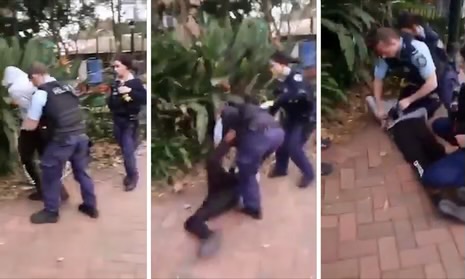
Introduction and Context
On June 1, 2020, a disturbing incident occurred in Ward Park, Surry Hills, Sydney, where Constable Ryan Barlow employed excessive force against a 16-year-old Aboriginal teenager, resulting in significant injuries. The teenager’s identity is protected for legal reasons. After a thorough investigation, Barlow was convicted of assault occasioning actual bodily harm in May 2023, sentenced to an 18-month community correction order with supervision in December 2023 and lost his appeal in November 2024. Despite this conviction, he remains employed by the NSW Police Force as of July 2025. This incident is not an isolated occurrence, but part of a broader pattern of systemic racism and violence against Aboriginal Australians, rooted in the colonial history of Australia and perpetuated by ongoing socioeconomic disparities.
This comprehensive analysis seeks to unpack these complex issues by integrating historical context, statistical data, case studies and policy recommendations. By incorporating the corrected figure of 3.8% for the Indigenous population as of July 10, 2025, we aim to reflect the demographic realities and advocate for systemic change.
Historical Context and Colonisation
The mistreatment of Aboriginal Australians can be traced back to the British colonisation that began in 1788. This colonisation was predicated on the doctrine of terra nullius, which disregarded the existence of Indigenous land rights and cultures. Throughout the 19th and early 20th centuries, various policies were enacted that further marginalised Aboriginal people, including the Protection Era, which confined them to missions and reserves and the Stolen Generations, where Indigenous children were forcibly removed from their families. These policies have led to profound intergenerational trauma that continues to affect Aboriginal communities today.
Policing during this era often served as a tool of oppression, with Native Police units enforcing colonial authority and perpetuating violence against Indigenous populations. The 1967 referendum was a significant milestone, as it allowed Aboriginal people to be counted in the census and empowered federal laws to address some inequalities. However, the aftermath of this referendum has shown that systemic issues persist. The Royal Commission into Aboriginal Deaths in Custody (RCIADIC) in 1991 investigated 99 deaths in custody and recommended 339 reforms, many of which remain unimplemented, highlighting ongoing challenges such as racial profiling and a lack of accountability within the justice system.
Impact of the Stolen Generations
The Stolen Generations, spanning from 1910 to the early 1970s, involved the systematic removal of Indigenous children from their families, often placing them in institutions or with non-Indigenous families. This practice not only severed familial bonds, but also forbade the practice of cultural traditions, leading to a loss of identity and heritage. The trauma experienced by those who were removed is linked to higher rates of mental health issues, substance abuse and interactions with the criminal justice system. Research indicates that children who were removed are significantly more likely to face incarceration later in life, perpetuating a cycle of disadvantage that affects not only those directly impacted, but also their descendants.
Intergenerational effects mean that even those who were not removed still feel the repercussions, which shape current social and economic conditions. Aboriginal Australians continue to face disparities in health, education and employment, resulting in ongoing challenges that must be addressed.
The Barlow Case: Detailed Case Study
The incident involving Constable Ryan Barlow serves as a critical case study that illustrates the broader systemic issues facing Aboriginal Australians. On June 1, 2020, Barlow responded to a verbal threat made by the teenager, who allegedly said, “I’ll crack you in the f—ing jaw, bro.” Barlow’s response was to use a “leg sweep” manoeuvre, which resulted in injuries to the teenager. Video evidence of the incident played a crucial role in the subsequent legal proceedings, leading to Barlow’s conviction for assault occasioning actual bodily harm in May 2023. His sentencing to an 18-month community correction order with supervision in December 2023 and the loss of his appeal in November 2024 raised significant concerns about accountability within the police force, especially given that he remains employed by the NSW Police Force as of July 2025.
This case is emblematic of broader patterns of excessive force used against Aboriginal individuals by police. Similar cases, such as the deaths of David Dungay Jr. in 2015 and Ms. Dhu in 2014, highlight the ongoing issues of police violence and the lack of accountability that often accompanies such incidents.
Statistical Disparities and Indigenous Population
As of July 2025, Aboriginal and Torres Strait Islander Australians represent approximately 3.8% of the total Australian population. However, they are disproportionately represented in the criminal justice system. As of March 2025, Indigenous Australians make up 37% of the prison population, a staggering overrepresentation. Furthermore, data from June 2024 indicates that Indigenous youth are 27 times more likely to be detained than their non-Indigenous counterparts.
Since the inception of the RCIADIC, there have been at least 580 recorded Indigenous deaths in custody, with 24 occurring in the 2023-2024 period alone. These statistics reveal a disturbing trend of systemic issues within the justice system, where historical and ongoing discrimination contribute to higher incarceration rates, poorer health outcomes and greater contact with law enforcement.
Moreover, disparities in life expectancy are stark: Indigenous males live, on average, 8.8 years less than non-Indigenous males, while Indigenous females have a life expectancy that is 8.1 years lower than that of their non-Indigenous counterparts. These figures underscore the urgent need for systemic change to address the root causes of these inequalities.
Systemic Racism in Policing
Systemic racism within policing manifests in various forms, including racial profiling and the over-policing of Indigenous communities. Minor offences often result in heightened police scrutiny of Indigenous youth, which perpetuates cycles of criminalisation. The excessive use of force, as evidenced in the Barlow case, reflects implicit biases within law enforcement and highlights the inadequacies in police training regarding cultural sensitivity and de-escalation techniques.
The lack of accountability for police misconduct further exacerbates the problem, as Barlow’s conviction remains an exception rather than the rule. Most cases of excessive force do not lead to charges against officers, fostering a culture of impunity. Socioeconomic factors, including poverty and housing instability, contribute to increased police interactions with Indigenous communities, while the effects of intergenerational trauma create a pervasive atmosphere of distrust towards law enforcement.
Media portrayals often reinforce negative stereotypes about Aboriginal Australians, exacerbating tensions between communities and police. Addressing these issues requires a multifaceted approach that considers the historical context and current realities faced by Indigenous Australians.
Personal Narratives and Human Impact
The human cost of systemic racism and police violence is starkly illustrated through personal narratives. The case of David Dungay Jr., a 26-year-old Dunghutti man who died in custody in 2015, is particularly poignant. Dungay repeatedly stated, “I can’t breathe” while being restrained, yet no charges were filed against the officers involved. His mother, Leetona Dungay, has since become a vocal advocate for justice, emphasising the need for accountability within the system.
Similarly, the tragic death of Ms. Dhu, a 22-year-old Yamatji woman who died in custody in 2014 from sepsis after being denied medical care, underscores the intersectional racism faced by Indigenous individuals. These personal stories highlight the urgent need for reform and accountability, as families continue to seek justice for their loved ones lost to systemic violence.
Community and Activist Responses
The Barlow case prompted significant community and activist responses, with organisations such as the National Aboriginal and Torres Strait Islander Legal Services (NATSILS) and Change the Record advocating for independent oversight and enhanced cultural training within police forces. The global protests following George Floyd’s death in 2020 inspired solidarity demonstrations in Australia, with calls for an end to Indigenous deaths in custody echoing throughout the nation.
Grassroots efforts, legal challenges and social media campaigns have raised awareness about the systemic issues faced by Aboriginal Australians. The Uluru Statement from the Heart, which calls for constitutional recognition and a First Nations Voice to Parliament, represents a significant step towards addressing historical injustices and ensuring that Indigenous voices are heard in the decision-making processes that affect their lives.
Policy Recommendations and Reforms
Addressing the systemic issues of racism and police violence requires a comprehensive approach that includes the implementation of the RCIADIC recommendations. Key reforms should include establishing independent oversight bodies to investigate police misconduct, providing de-escalation training for officers and reducing incarceration rates through diversionary programs that focus on rehabilitation rather than punishment.
Decriminalising minor offences and investing in education, health and housing for Indigenous communities are crucial steps toward addressing the root causes of systemic inequality. Supporting community-led initiatives, such as night patrols, can also enhance safety and trust within Indigenous communities.
Recent initiatives, such as the Closing the Gap framework, show promise, but gaps in implementation persist. Advocacy for adherence to international human rights standards and engagement with UN bodies can further pressure the Australian government to commit to meaningful change.
Conclusion and Future Directions
Incorporating the corrected figure of 3.8% for the Indigenous population underscores the urgent need for systemic change in Australia. The case of Constable Ryan Barlow serves as a stark reminder of the ongoing struggles faced by Aboriginal Australians. Historical legacies, statistical disparities and personal stories demand action from all levels of society.
Future directions should include ongoing legal challenges, the implementation of body-worn cameras for police and sustained advocacy for a justice system that respects and upholds Indigenous rights. As of July 2025, the path forward requires a collective commitment to reconciliation, empowerment of Aboriginal leadership and a shared vision for equity. Only through these efforts can we ensure that all Australians thrive in dignity and respect.
References
- Australian Bureau of Statistics. (12 June 2025). Corrective Services, Australia, March Quarter 2025.
- Australian Institute of Health and Welfare. (13 December 2024). Youth Detention Population in Australia 2024.
- Australian Institute of Criminology. (17 December 2024). Deaths in Custody in Australia 2023–24.
- The Guardian. (14 November 2024). Indigenous deaths in custody reach 22 in 11 months as advocates say numbers ‘met with indifference’.
- Australian Bureau of Statistics. (29 November 2023). Aboriginal and Torres Strait Islander Life Expectancy, 2020–2022.
- National Archives of Australia. (15 April 1991). Royal Commission into Aboriginal Deaths in Custody.
- Australian Museum. (22 June 2020). The Stolen Generation.
- National Indigenous Times. (29 December 2023). ‘I can’t breathe’: a mother still fighting for justice. ABC News.
- ABC News. (31 May 2024). WA Police, health service apologise to family of Ms Dhu 10 years after death in custody in South Hedland
- Uluru Dialogue. (2024). Uluru Statement from the Heart
- CNN. (13 June 2020). Protests across the globe after George Floyd’s death.
- Department of the Prime Minister and Cabinet. (July 2020) Closing the Gap.

